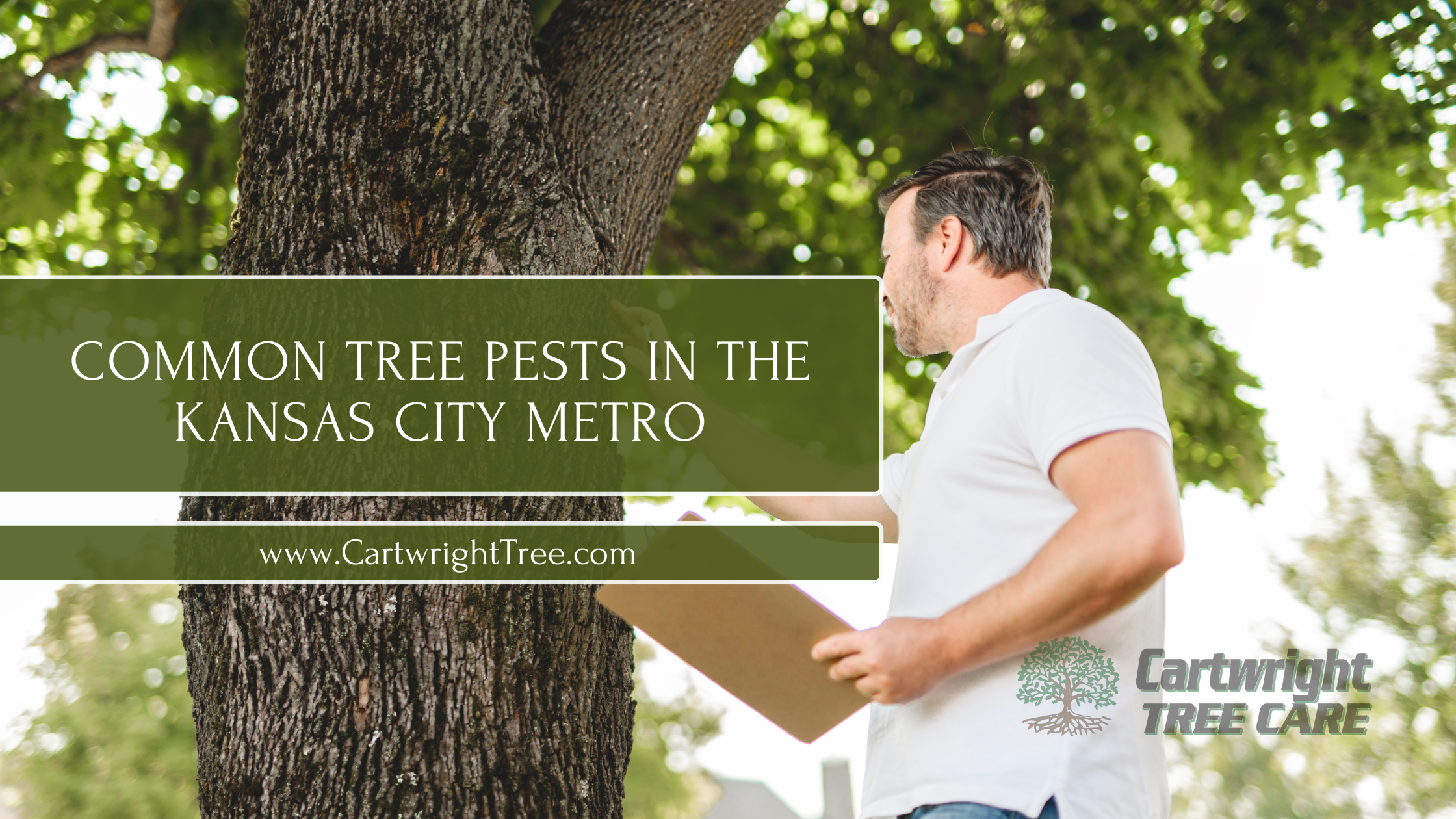How to Spot, Treat, and Prevent Insect Damage Before It Spreads
Kansas City’s tree canopy is one of its greatest treasures — from the old oaks of Brookside to the maples lining Lee’s Summit, our neighborhoods are full of life and shade. But those same trees that make our city beautiful are also prime real estate for a variety of pests that can cause serious damage if left untreated.
At Cartwright Tree Care, we’ve spent over 26 years protecting trees across the metro from insects that chew, bore, and sap away their strength. Understanding what to look for — and when to call an expert — can save your trees and prevent the spread of infestation.
Here are some of the most common tree pests we see in the Kansas City area, what they do, and how to stop them.
1. Emerald Ash Borer (EAB)
If you live in Kansas City, you’ve probably heard of this one — and for good reason. The Emerald Ash Borer is one of the most destructive invasive pests in North America.
-
What it looks like: Small, metallic green beetles about ½ inch long.
-
What it does: The larvae tunnel beneath the bark of ash trees, cutting off water and nutrients. Within 1–3 years, an infested tree will die.
-
Warning signs: Canopy thinning, vertical bark splits, D-shaped exit holes, and woodpecker activity.
-
Treatment: Preventative injections and soil treatments can save healthy ash trees. Once heavily infested, removal is often necessary to stop the spread.
2. Bagworms
Bagworms are a yearly battle for homeowners across the metro, especially in Blue Springs, Overland Park, and Raymore.
-
What they look like: Silken “bags” that hang from twigs — camouflaged with bits of bark and leaves.
-
What they do: Caterpillars feed on leaves and needles, stripping evergreens bare and defoliating deciduous trees.
-
Warning signs: Small brown cones hanging from branches that wiggle in early summer — those are active bagworms!
-
Treatment: Early detection is key. Hand-remove small infestations; for larger ones, professional insecticide applications are most effective in late May to early June.
3. Scale Insects
These pests are sneaky — they look more like bumps on bark than bugs, but they can do major damage over time.
-
What they look like: Tiny, round or oval shells on stems or leaves.
-
What they do: Suck sap from trees, causing yellowing leaves, dieback, and a sticky “honeydew” residue that attracts ants and fungus.
-
Common hosts: Maples, magnolias, oaks, and ornamental shrubs.
-
Treatment: Dormant oil applications in winter or systemic insect treatments in spring are highly effective when applied by a professional.
4. Japanese Beetles
While beautiful in color, Japanese beetles are destructive feeders that can strip your landscape in days.
-
What they look like: Metallic green and copper beetles about ⅜ inch long.
-
What they do: Feed on over 300 plant species, skeletonizing leaves on lindens, crabapples, and roses.
-
Warning signs: Lace-like leaves, brown edges, and clusters of beetles feeding in sunlight.
-
Treatment: Hand removal for small outbreaks or professional foliar sprays to control severe infestations.
5. Borers (Other Than EAB)
Kansas City trees also deal with other wood-boring insects like pine sawyers, oak borers, and maple borers.
-
What they do: Tunnel through bark and sapwood, weakening structure and opening the door to fungal infections.
-
Warning signs: Sawdust piles near the base, small round exit holes, and canopy dieback.
-
Treatment: Preventative trunk injections and improving tree health through proper fertilization and watering. Healthy trees are less likely to be attacked.
6. Aphids & Mites
These tiny sap-suckers often go unnoticed until the damage becomes visible.
-
What they do: Feed on young leaves, causing curling, yellowing, and sticky residue.
-
Common hosts: Maples, elms, and many ornamental species.
-
Treatment: Beneficial insects like ladybugs help naturally control populations, but severe infestations may require horticultural oils or insecticidal soap treatments.
Preventing Tree Pest Problems
The best pest control is proactive care. Regular maintenance — including tree trimming, fertilization, and inspection — helps catch early signs of infestation and strengthens your trees’ natural defenses.
Our Tree Health Experts provide:
-
Annual pest monitoring and risk assessments
-
Preventative trunk and soil treatments
-
Deep root fertilization to boost tree immunity
-
Expert pruning to remove infected areas safely
Healthy trees are naturally resilient — but even the strongest can fall victim if pests go unchecked.
Protect Your Trees with Kansas City’s Trusted Experts
At Cartwright Tree Care, our ISA-certified arborists know the pests that call Kansas City home — and the best way to keep them from making your yard theirs.
If you notice thinning canopies, sticky residue, or strange holes in the bark, don’t wait. Early intervention can mean the difference between saving a tree and losing it.
📞 Contact Cartwright Tree Care today for a pest evaluation or customized treatment plan to protect your trees all year long.
Proudly serving Kansas City, Overland Park, Lee’s Summit, Liberty, Raymore, and surrounding communities.

